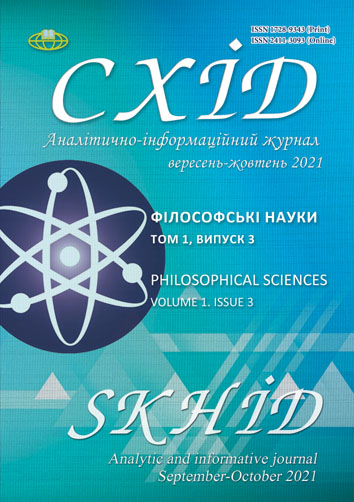TWO ATTEMPTS TO FORECAST THE RENAISSANCE AS A REFLECTION OF EXTRAPOLATION METHODOLOGY
DOI:
https://doi.org/10.21847/1728-9343.2021.1(3).271629Keywords:
broadcast empire, futurology, Renaissance, social forecasting, astrology, scientific objectivity of COVID-19, forecast verificationAbstract
The article focuses on continuous research and everyday interest in the Renaissance culture in general and research methods of this period in particular. Accepting the multi-vector nature of the Renaissance methodological culture as a whole, the author's attention is focused primarily on the prognostic methodology as such, which has a priority beginning in the general futurology of the Renaissance problems. The article examines and compares two attempts at forecasting, one of which belongs to Yuriy Kotermak - a Ukrainian scientist, and the second - to the Pskov monk Philotheus. Based on the comparison of the core axiological emphases and comparison by different criteria, some generalizations about the nature of intellectual traditions to the authors of these forecasts belonged to are proposed. The ideas about scientific objectivity of the era, particularly in relation to astrology, are clarified. Considerable attention is paid to the analysis of the thesis on the inheritance of the traditions of the Byzantine Empire formulated by Philotheus, including in the context of the restoration of canonical ties of Ukrainian Orthodoxy with the Ecumenical Patriarchate. Finally, the concept of futurological relevance of further research of the stated forecasting methods is suggested.
Downloads
References
Bichuya, Nina (970). Drohobytskyy zvizdar. Kyiv, Radiznskyy pysmennyk (In Ukrainian).
Bourdon, Étienne (2017). Temporalities and History in the Renaissance. Journal of Early Modern Studies, 6, 39-60. https://doi.org/10.13128/JEMS-2279-7149-20388 DOI10.13128/JEMS-2279-7149-20388
Drohobych, Yu. (1999). Uryvok zayavy papi Sikstovi IV [per. z latyn. V. Lytvynova] (p.46). In: M. Schalata (1999). Yuriy Drohobych i yoho doba. Truskavetsʹ (In Ukrainian)
Drohobych, Yu. (2003). Prohnostychna otsinka 1483 roku. In: O.O.Lyubar, M. H. Stelmakhovych, D. T. Fedorenko. Istoriya ukrayinskoyi shkoly i pedahohiky. Kyiv (In Ukrainian)
Hayday, L. (2000). Istoriya Ukrayiny v osobakh, terminakh, nazvakh i ponyattyakh. Lutsk, Vezha (In Ukrainian).
Hrubyak, O. M. (comp.) (2017). Yuriy Drohobych (Kotermak): biobibliohr. pokazhchyk. Drohobych, RVV DDPU im. Ivana Franka (In Ukrainian)
Kolesov, V.V. (comp. und komment.) (2000). Poslaniya startsa Filofeya (Vol. IX). St.Petersburg, Nauka (In Russian).
Malytskyy, F. (1970). Zahravy nad Buhom. Kyiv. P. 280. (In Ukrainian).
Nelson, Leif D., Simmons, Joseph, and Simonsohn, Uri (2017). Psychology's Renaissance. Annual Review of Psychology. Vol. 69: 511-534 https://doi.org/10.1146/annurev-psych-122216-011836].
Nichyk, V. M. (1990). Humanistychni i reformatsiyni ideyi na Ukrayini (XVI – pochatok XVII st.) (P. 20). In: V. M. Nichyk, V. D. Lytvynov, YA. M. Stratiy. Kyiv (In Ukrainian).
Oklopcic, B. (2017). Southern Renaissance and the Image of the South in the 1940s-1960s American History textbooks. Folia Linguistica et Litteraria, 19, 81-97 https://www.ceeol.com/search/journal-detail?id=1758
Petrova, I. (2018). Renaissance villa: leisure practices and cultural consumption. National Academy of Managerial Ыtaff of Сulture and Arts Herald, 1, pp.37-41
Downloads
Published
How to Cite
Issue
Section
License
Copyright (c) 2023 Надія Павлусів

This work is licensed under a Creative Commons Attribution-NonCommercial-NoDerivatives 4.0 International License.
1. Authors bear responsibility for the accuracy of facts, quotations, numbers and names used.
2. Manuscripts are not sent back.
3. The publisher does not always agree with the authors' opinion.
4. The authors reserve the right to authorship of the work and pass the first publication right of this work to the journal under the terms of a Creative Commons Attribution-NonCommercial-NoDerivatives 4.0 International License. This license allows others to distribute (copy) the published work for non-commercial purposes, provided there is mandatory attribution to its authors and a link to the first publication in our journal.
5. The authors have the right to conclude separate supplement agreements that relate to non-exclusive work distribution in the form in which it has been published by the journal (for example, to upload the work to the online storage of the journal or publish it as part of a monograph), provided that the reference to the first publication of the work in this journal is included.

